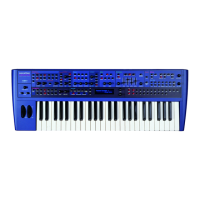tion the Arp will behave as above except that it will stop when it reaches the end of the pattern. This is like playing a loop on a
sampler. Again another powerful feature for live performance. The range of this parameter is Constant & Pattern. This parameter is
memorised with a Program.
The lower parameter is “Quantise”. In this case with a value of Mode 1.
This parameter determines if the Arpeggiation played is quantised to the Arp Sync parameters time signature or not. Use the lower
Data knob to adjust the value. The Arpeggiator can correct timing errors for you in several different ways. The arpeggiator can cor-
rect timing errors by quantising the played notes like a sequencer package. ( we will refer to this method as “Quantised”) This cor-
rects the mistakes but can introduce a “Skip” if you play late. i.e. the first note played is on the next quantised step. This is what
would happen in a sequencer as well but can be not so useful for live performance so we have introduced a kind of “Intelligent
Quantise”. i.e. If you play slightly late those notes will sound immediately & the next step will be quantised. Additionally things
change if MIDI Clock is being used. The Arpeggiator reads MIDI Start/Continue Messages. The pattern will start when one of these
messages is received, but will not make any sound. When the master keyboard is played in this condition, the Arpeggiator will play
the correct step in the pattern, not start from the beginning of the pattern. Below is a table showing the different options:
MODES
Off = Not quantised.
Mode 1 = Quantised.
Mode 2 = Intelligently quantised.
Mode 3 = Quantised with the pattern locked to the sequencer & other quantised Arpeggiators.
Mode 4 = Intelligently quantised with the pattern locked to the sequencer & other quantised Arpeggiators.
The range of this parameter is Off, Mode 1, Mode 2, Mode 3 & Mode 4. This parameter is memorised with a Program.
In Performances if more than one Part has a Program with Arpeggiators activated & if these Programs have the Arpeggiators
“Quantise” parameter set to active ( modes 1, 2, 3 or 4 ) then activating any Arpeggiator will start all of the Arpeggiators in the
Performance in Sync with each other. ( Although you wont actually hear them until the correct Range and/or MIDI channel is trig-
gered ) This means that the phrases created by the separate Arpeggiators are always in sync even if triggered at different times.
This parameter also affects how the Keysync parameter on the front panel behaves. Refer page 58 for details.
Page 3 looks like so:
The higher parameter is “Velocity”. In this case with a value of Played.
This parameter determines how the velocity of the notes played effect the notes in the arpeggiation. Use the upper Data knob to
adjust the value . If this parameter is set to “Played” then the velocities of the notes played will be duplicated in the notes played in
the arpeggiation. If this parameter is set to “Full” ”then the velocities of the notes played will be at full velocity. ( 127 ) If this para-
meter is set to “Half” then the velocities of the notes played will be at half velocity. ( 63) If this parameter is set to “Prog” then the
velocities of the notes played will be at the values programmed into the patterns. The range of this parameter is Played, Full, Half
& Prog. This parameter is memorised with a Program.
The upper parameter is "Octave range", in this example with a value of 1.
This parameter determines the number of octaves the Arpeggiator will sweep through. Use the lower Data knob to adjust the value.
The range of this parameter is 1, 2, 3 & 4 Octaves. This parameter is memorised with a Program.
When this parameter is set to use octaves greater than 1, then the “Fill in” parameter will affect how the the pattern sweeps
through the octaves on the Monophonic Up/Down patterns ( Mono 000 to 003 ). Refer to the notes on the “Fill in” parameter on
page 56 for details.

